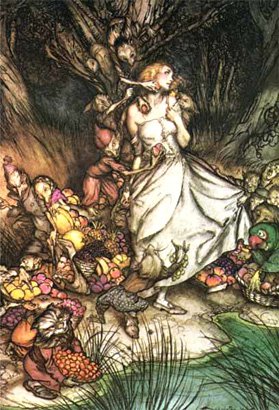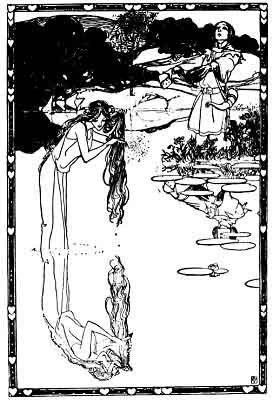Fairies are coming to St John’s: the Modern Fairies project
The project will explore how this material can be re-mediated by award-winning artists and made relevant to modern audiences. Professor Larrington writes:
 ‘In 2015 I published a book called The Land
of the Green Man. A Journey Through
the Supernatural Landscapes of the British Isles. This was the product of a good many years of thinking about the larger
narrative patterns of traditional English folktales. Despite the early to mid-twentieth-century
view that such stories were unmodern and irrelevant, in fact, I argued, in the
past traditional tales did important work. They allowed people to think about
inescapable facts of existence: to wonder about life and death, children and
animals, riches and poverty, love and desire and to dream about other
possibilities for their lives and their descendants. These stories aren’t mere
escapist tales, or simple examples of magical thinking, but rather, in their
stripped-down clarity, they show what’s really important to people in a fresh
and unfamiliar light.
‘In 2015 I published a book called The Land
of the Green Man. A Journey Through
the Supernatural Landscapes of the British Isles. This was the product of a good many years of thinking about the larger
narrative patterns of traditional English folktales. Despite the early to mid-twentieth-century
view that such stories were unmodern and irrelevant, in fact, I argued, in the
past traditional tales did important work. They allowed people to think about
inescapable facts of existence: to wonder about life and death, children and
animals, riches and poverty, love and desire and to dream about other
possibilities for their lives and their descendants. These stories aren’t mere
escapist tales, or simple examples of magical thinking, but rather, in their
stripped-down clarity, they show what’s really important to people in a fresh
and unfamiliar light.
picture: A fairy changeling
In early 2016 Fay Hield got in touch, wondering if there might be some way of bringing less well-known traditional tales and the folk-singing community together, to try to generate new songs about timeless themes, and to try to discover how audiences might react to them. We narrowed down the focus of the project to stories about fairies and loathly ladies: the kinds of figures that you might encounter in the greenwood when you least expected it.
Fay and I decided to include other kinds of artists, poets, writers, film-makers and painters, as well as the musicians. So I set to work to find the kinds of stories that might speak to creative folk, to harness their imaginations in order to make new songs, paintings, poems and performances out of the many tales recorded in the British Isles.
 Tales about fairies (NOT fairy tales, the term used for
international stories such as Cinderella
or Little Red Riding Hood) are found
all over the country, often closely associated with particular locations. Some
form part of medieval romances, in long often complex poems. Others are
preserved in ballads, simple rhymes which were sung to different tunes and
handed down by singers through the generations. Many more were collected by
nineteenth-century enthusiasts, ladies of the manor with time on their hands, parsons
and doctors, who went about their counties asking ordinary folk what stories
they knew from the parish.
Tales about fairies (NOT fairy tales, the term used for
international stories such as Cinderella
or Little Red Riding Hood) are found
all over the country, often closely associated with particular locations. Some
form part of medieval romances, in long often complex poems. Others are
preserved in ballads, simple rhymes which were sung to different tunes and
handed down by singers through the generations. Many more were collected by
nineteenth-century enthusiasts, ladies of the manor with time on their hands, parsons
and doctors, who went about their counties asking ordinary folk what stories
they knew from the parish.
These tales are widely distributed across the British Isles and are often very similar, varying only in minor details and the locales with which they are associated. The tales I have chosen for the project then come from all over the country; it is often the case that, although I may have found an example from Suffolk or Devon, there are very similar tales from Northumberland or South Wales.
picture: Lady of Llyn y Fan Fach
The kinds of stories that are recorded about fairies fall into distinct thematic areas. Fairies are essentially rule-bound creatures, with their own particular agendas. They are neither good nor evil, but rather operate neutrally, rewarding mortals who aid them and punishing those who infringe their rights. But they are also on the look-out for opportunities: enticing or kidnapping children or young women into fairyland, exchanging their ugly, wizened children for plump, thriving human babies, and they are keen to keep out of the way of the church and its priests who threaten to drive them from their haunts.
Some address questions about work and its rewards, about death and loss, and the lengths to which people will go to try to win back those they love. Others give a sense of the allure of the otherness of fairyland, its castles and richly-decorated halls, its crimson wines and deliciously insubstantial food, the kinds of luxuries that ordinary folk long for. The loathly lady, enchanted into hideousness by a wicked stepmother, challenges the hero she meets; can he see past her monstrosity to the person within, and make the right decisions to release her into her true self?
Thus they fall under five different headings: adventures in fairyland, fairy wives and human brides, fairies and children, fairy helpers and the loathly lady. Each of these domains speaks to different aspects of human existence, of loss, love, longing and luck.
I can’t wait to see what our team of creative artists makes of them. We kick off with a two-day workshop at St John's on 2–3 July, where the artists and the research team will meet for the first time and will dive straight down into the tarn of tales to find new inspiration for their contemporary retellings.’
Find out more about the project at Modern Fairies and Loathly Ladies.